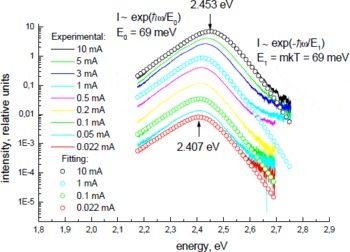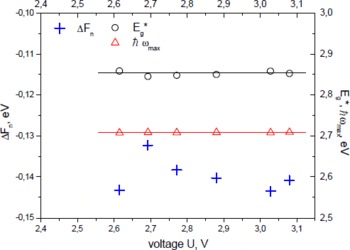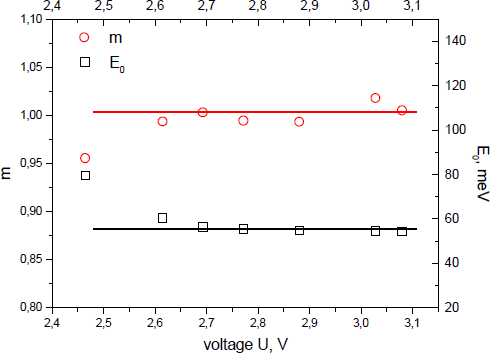Introduction
The problems of recombination mechanisms in InGaN/AlGaN/GaN heterostructures are not fully understood in spite of great progress in the development of GaN-based light-emitting diodes (LEDs). We have studied luminescence spectra of two groups of LED’s based on structures with single InGaN quantum wells (SQWs, sent to Moscow University by Dr. S.Nakamura, Nichia Chemical Co.) and multiple quantum wells (MQWs, sent to Moscow University by Dr. M.Koike, Toyoda Gosei Co.) in a wide range of currents [Reference Zolina, Kudryashov, Turkin, Yunovich and Nakamura2-Reference Koike, Koide, Asami, Umezaki, Nagai, Yamasaki, Shibata, Amano and Akasaki6]. A model of radiative recombination in 2D-structures with band tails caused by potential fluctuations was successfully applied to describe the spectra [Reference Zolina, Kudryashov, Turkin, Yunovich and Nakamura2-Reference Yunovich, Manyachin, Kudryashov, Turkin and Zolina4]; tunnel radiative recombination was detected at low currents [Reference Kudryashov, Zolina, Turkin, Yunovich, Kovalev and Manyakhin5]. In this work spectra of blue and green LEDs with SQW and MQW active layers are compared and the model of recombination is analyzed. Changes of the parameters with current J and voltage V are discussed.
Experimental results
Both groups of LEDs were based on heterostructures grown on sapphire substrates by a MOCVD [Reference Zolina, Kudryashov, Turkin, Yunovich and Nakamura2, Reference Koike, Koide, Asami, Umezaki, Nagai, Yamasaki, Shibata, Amano and Akasaki6]. A buffer layer was of GaN in Nichia samples [Reference Zolina, Kudryashov, Turkin, Yunovich and Nakamura2] and of AlN in Toyoda samples [Reference Koike, Koide, Asami, Umezaki, Nagai, Yamasaki, Shibata, Amano and Akasaki6]. The base layer was n-GaN:Si (4-5 mm).
The active layers of the structures were different: an SQW InxGa1−xN (>3.5 nm) in Nichia LEDs and MQW InxGa1−xN/GaN (5 periods, a width of the period < 8 nm). Indium content (x in InxGa1−xN) varied in both cases (near x = 0.2 for green and near x = 0.4 for blue LEDs). Upper layers p-AlGaN:Mg and cap layers p-GaN:Mg have hole concentrations in the range p = 5.1017−2.1018 cm−3, higher for blue SQWs.
The spectra of blue and green LEDs with SQWs and MQWs are shown in a wide range of J (see Figs. 1, 2). The spectra of LEDs with SQWs could be measured down to 15 μA, that ones with MQWs to 0.15 μA. The cause of this difference is a tunnel component of nonradiative current most pronounced in blue LEDs with SQWs. Values of ħωmax (≈2.65 eV) for blue SQWs LEDs do not depend on J.

Figure 1a. Electroluminescence spectra of blue LED with SQW

Figure 1b. Electroluminescence spectra of blue LED with MQW.

Figure 2a. Electroluminescence spectra of green LED with SQW

Figure 2b. Electroluminescence spectra of green LED with MQW.
There is another spectral band on the low energy side of the main blue line at low currents (see Fig. 1a). The maximum of this band is moving with the current J and voltage on the active layer U:ħωmax= eU+Δ (in the range = 2.1−2.3 eV). This band was described as a tunnel radiative recombination [Reference Yunovich, Manyachin, Kudryashov, Turkin and Zolina4,Reference Kudryashov, Zolina, Turkin, Yunovich, Kovalev and Manyakhin5]. There is no tunnel band in blue LEDs with MQWs; in this case the blue line is moving with V.
Values of ħωmax for green LEDs, both SQWs and MQWs, are moving with J and V, but in a wider range for MQWs: 2.2÷2.45 eV. A new band was detected at the high energy side (2.7÷2.8 eV) of the green line of MQWs (see Fig. 2b).
The main spectral lines have exponential tails: I(ħωmax) ∼ exp(ħωmax/E0) on the low energy side and I(ħωmax) ∼ exp(-ħωmax/E1) on the high energy side of the peaks. Values of E0 = 50÷60 meV did not depend on the current and temperature T in a wide range of J. Values of E1 were proportional to T: E1 = mkT; 1 < m < 2; m is almost equal to unity for SQWs and is in the range m = 1.5−1.7 for MQWs. E1 was growing at higher direct currents, J >5 mA, due to heating of the LEDs.
Current-voltage characteristics J(V) of blue and green LEDs had an exponential part at low currents, J < 10−7 A at 300 K, a steep exponential growth in the range V = 2.3−2.7 V, a linear part at higher currents, J > 20 mA. Low currents could be understood as a tunnel component; tunnel currents in these LEDs play some role at J 3-4 orders of magnitude lower than that for SQWbased LEDs [Reference Zolina, Kudryashov, Turkin, Yunovich and Nakamura2-Reference Kudryashov, Zolina, Turkin, Yunovich, Kovalev and Manyakhin5,Reference Yunovich, Kovalev, Kudryashov, Manyachin, Turkin and Zolina7]; J(V) curves of SQW-based LEDs differed from MQW-based LEDs because of a wider active layer [Reference Yunovich, Kudryashov, Turkin, Kovalev and Manyachin1].
A good approximation of the J(V) curves for MQW LEDs was done when not only a series resistance Rs at the linear part at higher J was taken into account, but also the quadratic part: J ∼ (V−V1)2. The fit of the curve J(V) at J > 0.1 mA by the equation:
A part ∼(J/J1)0.5 is sufficient between an exponential (injection) and a linear parts, in the range J=2÷30 mA, at usual working currents [Reference Yunovich, Kudryashov, Turkin, Kovalev and Manyachin1].
Distributions of charged centers in p- regions of InGaN/AlGaN/GaN p-n- heterostructures with MQWs and SQWs are shown, see Fig. 3 (see a method of measurements in [Reference Manyakhin, Kovalev, Kudryashov, Turkin and Yunovich8]). The LEDs with MQWs have wider space charge width than ones with SQWs [Reference Zolina, Kudryashov, Turkin, Yunovich and Nakamura2-Reference Kudryashov, Zolina, Turkin, Yunovich, Kovalev and Manyakhin5,Reference Yunovich, Kovalev, Kudryashov, Manyachin, Turkin and Zolina7]; in both cases the width for green LEDs is wider than for blue ones. This fact corresponds to a low probability of tunnel effects in the LEDs with MQWs.

Figure 3. Distributions of charged centers in p-regions of p-n-heterojunctions; points - values of NA − at V = 0; begining of abscissa is at the n-interface. Blue (1,3) and green (2,4-6) LEDs with SQW (1,2) and MQW (3, 4-6).
It seems that high Mg-doping of p- AlGaN and GaN- layers is more difficult for higher In concentration in InGaN active layers.
Discussion
We describe the main lines in spectra with a model previously applied for fitting the spectra of LEDs with SQW [Reference Yunovich, Kudryashov, Turkin, Kovalev and Manyachin1-Reference Zolina, Kudryashov, Turkin and Yunovich3]. The model implies that an effective radiative recombination takes place when carriers of both singes are injected into the active layer at voltages on the layer U < V, U close to φk. Optical transitions ħω are going between states E(c) and E(v) in tails of 2D-structure, caused by potential fluctuations. A model 2D- joint density of states is

an effective energy gap Eg* = Eg(x,T)+Δ E1c+ΔE1v+ΔEp-Eexc−ΔED,A,
where Eg(x,T) – the energy bandgap in the active layer - QW, ΔE1c,Δ E1v – quantum size energy levels in conduction and valence bands, ΔEp- lattice deformation shift, Eexc- energy of 2D-exciton, ΔED,A- donor-aceptor potential shift of the effective bandgap. The values Eg received from this model are 2.98-3.05 eV for blue and 2.67-2.76 eV for green LED [Reference Zolina, Kudryashov, Turkin and Yunovich3]. Spectral intensity I(ħω) is proportional to Fermi-functions of electrons and holes with quasi-Fermi levels Fn, Fp as parameters (details in [Reference Zolina, Kudryashov, Turkin, Yunovich and Nakamura2,Reference Zolina, Kudryashov, Turkin and Yunovich3]):

Examples of the fit are shown in Figs. 2, 3. A change of ħωmax in some range of J is caused mostly by changes of the parameter Fn; states in the tails are filled as V and J are growing (see Fig. 4). Parameters of the fit Eg*, E0, E1 = m kT can be seen in Figs. 4, 5 for blue MQWs and SQW. There is the evidence that a mechanism of recombination in the 2D-tail of states is not changed in some range. It is remarkable that when this mechanism begins the quantum efficiency ηe reaches a maximum (see Fig. 5b). When the states in the active layers are filled by current carriers at high J, the quantum efficiency ηe gradually falls.

Figure 4a. Dependence of fitting parameters (ΔFn, Eg*, ħωmax) on the voltage for blue LED with SQW

Figure 4b. Dependence of fitting parameters (ΔFn, Eg*, ħωmax) on the voltage for blue LED with MQW.

Figure 5a. Dependence of fitting parameters (m, E0) on the voltage for blue LED with SQW.

Figure 5b. Dependence of fitting parameters (m, E0) and quantum efficiency ηe on the voltage for blue LED with MQW.
There is a change of mechanism of recombination at lower currents; this can be concluded from Fig. 5b in spite of scattering of the points. Comparing spectra in the Figs. 1a and 1b we assume that this change is somewhat connected with tunneling.
A change of mechanism of recombination at higher currents in green LEDs, pronounced as a new band in Fig. 2b, can be connected with nonuniform distribution of Indium in the active layers InGaN more probable at higher In content.
Conclusions
Mechanism of radiative recombination in 2D- structures with band tails describe the main line in the spectra of both groups blue and green LEDs, with SQWs and MQWs, in a wide range of currents. The main difference in spectra of two groups is a role of tunnel effects at low currents in LEDs with SQWs. Moving of spectra with the voltage is more pronounced in green LEDs due to higher content of Indium and more pronounced density of states tails in the active InGaN layers.
Acknowledgments
Authors thank Dr. S.Nakamura (Nichia Chemical Co.) and Dr. M.Koike (Toyoda Goasei Co.) for sending LEDs to Moscow University; S.S.Mamakin and R.V.Grigoryev for help in measurements.










